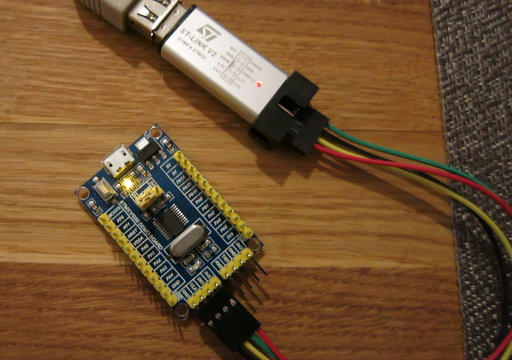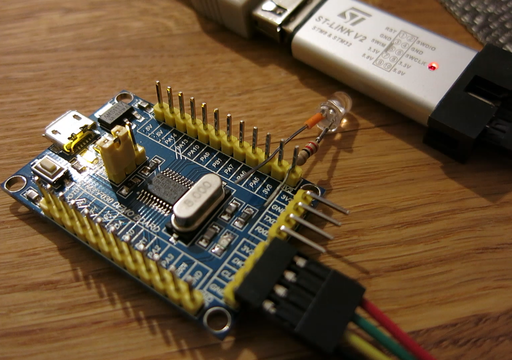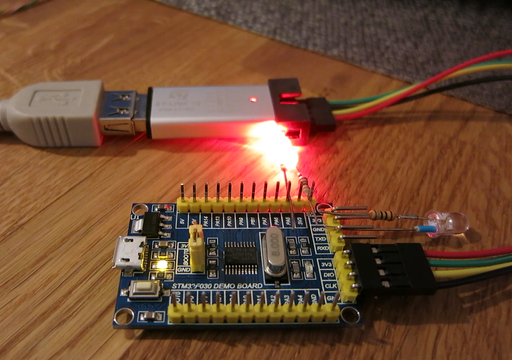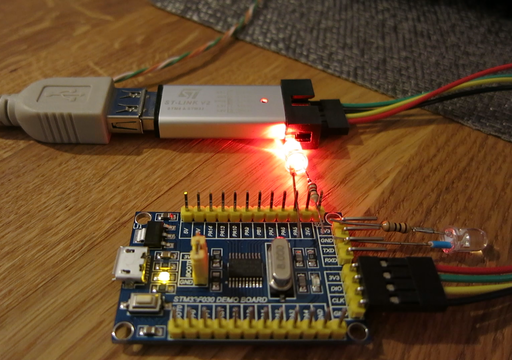19 KiB
wenwensnow is translating
Go on very small hardware (Part 1) Go语言在极小硬件上的运用(第一部分)
How low we can Go and still do something useful? Go 语言,能在多低下的配置上运行并发挥作用呢? I recently bought this ridiculously cheap board: 我最近购买了一个特别便宜的开发板:
I bought it for three reasons. First, I have never dealt (as a programmer) with STM32F0 series. Second, the STM32F10x series is getting old. MCUs belonging to the STM32F0 family are just as cheap if not cheaper and has newer peripherals, with many improvements and bugs fixed. Thirdly, I chose the smallest member of the family for the purpose of this article, to make the whole thing a little more intriguing. 我购买它的理由有三个。首先,我(作为程序员)从未接触过STM320系列的开发板。其次, STM32F10x系列使用的频率也在降低。STM320系列的MCU很便宜,有更新的外设,对系列产品进行了改进,问题修复也做得更好了。最后,我为了这篇文章,选用了这一系列中最低配置的开发板,整件事情就变得有趣起来了。
硬件部分
STM32F030F4P6 给人留下了很深的印象:
-
CPU: Cortex M0 48 MHz (最低配置,只有12000个逻辑门电路),
-
RAM: 4 KB,
-
Flash: 16 KB,
-
ADC, SPI, I2C, USART 和几个定时器,
all enclosed in TSSOP20 package. As you can see, it is very small 32-bit system. 以上这些采用了TSSOP20封装。正如你所见,这是一个很小的32位系统。
软件部分
If you hoped to see how to use Go to program this board, you need to read the hardware specification one more time. You must face the truth: there is a negligible chance that someone will ever add support for Cortex-M0 to the Go compiler and this is just the beginning of work. 如果你想知道如何在这块开发板上使用 Go 编程,你需要反复阅读硬件手册。你必须明白:有人在Go 编译器中给Cortex-M0提供支持,可能性很小。而且,这还仅仅只是第一个要解决的问题。
I’ll use Emgo, but don’t worry, you will see that it gives you as much Go as it can on such small system. 我会使用Emgo,但别担心,你会在之后看到,它如何让Go在如此小的系统上尽可能发挥作用。
There was no support for any F0 MCU in stm32/hal before this board arrived to me. After brief study of RM, the STM32F0 series appeared to be striped down STM32F3 series, which made work on new port easier. 在我拿到这块开发板之前,对 stm32/hal 系列下的F0 MCU 没有任何支持。在简单研究 参考手册后,我发现 STM32F0系列是STM32F3的一个基础,这让
如果你想接着本文的步骤做下去,需要先安装Emgo
cd $HOME
git clone https://github.com/ziutek/emgo/
cd emgo/egc
go install
然后设置一下环境变量
export EGCC=path_to_arm_gcc # eg. /usr/local/arm/bin/arm-none-eabi-gcc
export EGLD=path_to_arm_linker # eg. /usr/local/arm/bin/arm-none-eabi-ld
export EGAR=path_to_arm_archiver # eg. /usr/local/arm/bin/arm-none-eabi-ar
export EGROOT=$HOME/emgo/egroot
export EGPATH=$HOME/emgo/egpath
export EGARCH=cortexm0
export EGOS=noos
export EGTARGET=f030x6
更详细的说明可以在 Emgo网站上找到。
Ensure that egc is on your PATH. You can use go build instead of go install and copy egc to your $HOME/bin or /usr/local/bin .
要确保 egc 在你的PATH 中。 你可以使用 go build 来代替 go install,然后把 egc 复制到你的 $HOME/bin 或 /usr/local/bin 中。
现在为你的第一个Emgo程序创建一个新文件夹,随后把示例中链接器脚本复制过来:
mkdir $HOME/firstemgo
cd $HOME/firstemgo
cp $EGPATH/src/stm32/examples/f030-demo-board/blinky/script.ld .
最基本程序
在 main.go 文件中创建一个最基本的程序:
package main
func main() {
}
文件编译没有出现任何问题:
$ egc
$ arm-none-eabi-size cortexm0.elf
text data bss dec hex filename
7452 172 104 7728 1e30 cortexm0.elf
第一次编译可能会花点时间。编译后产生的二进制占用了7624个字节的Flash空间(文本+数据)。对于一个什么都没做的程序来说,所占用的空间有些大。还剩下8760字节,可以用来做些有用的事。 The first compilation can take some time. The resulting binary takes 7624 bytes of Flash (text+data), quite a lot for a program that does nothing. There are 8760 free bytes left to do something useful.
不妨试试传统的 Hello, World! 程序:
package main
import "fmt"
func main() {
fmt.Println("Hello, World!")
}
不幸的是,这次结果有些糟糕:
$ egc
/usr/local/arm/bin/arm-none-eabi-ld: /home/michal/P/go/src/github.com/ziutek/emgo/egpath/src/stm32/examples/f030-demo-board/blog/cortexm0.elf section `.text' will not fit in region `Flash'
/usr/local/arm/bin/arm-none-eabi-ld: region `Flash' overflowed by 10880 bytes
exit status 1
Hello, World! 需要 STM32F030x6 上的 至少32KB 的Flash空间.
The fmt package forces to include whole strconv and reflect packages. All three are pretty big, even a slimmed-down versions in Emgo. We must forget about it. There are many applications that don’t require fancy formatted text output. Often one or more LEDs or seven segment display are enough. However, in Part 2, I’ll try to use strconv package to format and print some numbers and text over UART. fmt 包强制包含整个 strconv 和 reflect 包。这三个包,即使在精简版本中的Emgo中,占用空间也很大。我们不能使用这个例子了。有很多的应用不需要好看的文本输出。通常,一个或多个LED,或者七段数码管显示就足够了。不过,在第二部分,我会尝试使用 strconv 包来格式化,并在UART 上显示一些数字和文本。
闪烁
我们的开发板上有一个与PA4引脚和 VCC 相连的LED。这次我们的代码稍稍长了一些:
package main
import (
"delay"
"stm32/hal/gpio"
"stm32/hal/system"
"stm32/hal/system/timer/systick"
)
var led gpio.Pin
func init() {
system.SetupPLL(8, 1, 48/8)
systick.Setup(2e6)
gpio.A.EnableClock(false)
led = gpio.A.Pin(4)
cfg := &gpio.Config{Mode: gpio.Out, Driver: gpio.OpenDrain}
led.Setup(cfg)
}
func main() {
for {
led.Clear()
delay.Millisec(100)
led.Set()
delay.Millisec(900)
}
}
By convention, the init function is used to initialize the basic things and configure peripherals. 按照惯例, init 函数用来初始化和配置外设。
system.SetupPLL(8, 1, 48/8) 用来配置RCC,将外部的8 MHz振荡器的PLL作为系统时钟源。PLL 分频器设置为1,倍频数 设置为 48/8 =6,这样系统时钟频率为48MHz.
systick.Setup(2e6) 将 Cortex-M SYSTICK 时钟作为系统时钟,每隔 2e6次纳秒运行一次(每秒钟500次)。
gpio.A.EnableClock(false)
enables clock for GPIO port A. False means that this clock should be disabled in low-power mode, but this is not implemented int STM32F0 series.
开启了 GPIO A 口的时钟。 False 意味着这一时钟在低功耗模式下会被禁用,但在STM32F0系列中没有实现这一模式。
led.Setup(cfg) 设置 PA4 引脚为开漏输出.
led.Clear() 将 PA4 引脚设为低, 在开漏设置中,打开LED.
led.Set() 将 PA4 设为高电平状态 , 意为关掉LED.
编译这个代码:
$ egc
$ arm-none-eabi-size cortexm0.elf
text data bss dec hex filename
9772 172 168 10112 2780 cortexm0.elf
As you can see, blinky takes 2320 bytes more than minimal program. There are still 6440 bytes left for more code. 正如你所看到的,闪烁占用了2320 字节,比最小程序占用空间要大。还有6440字节的剩余空间。
看看代码是否能运行:
$ openocd -d0 -f interface/stlink.cfg -f target/stm32f0x.cfg -c 'init; program cortexm0.elf; reset run; exit'
Open On-Chip Debugger 0.10.0+dev-00319-g8f1f912a (2018-03-07-19:20)
Licensed under GNU GPL v2
For bug reports, read
http://openocd.org/doc/doxygen/bugs.html
debug_level: 0
adapter speed: 1000 kHz
adapter_nsrst_delay: 100
none separate
adapter speed: 950 kHz
target halted due to debug-request, current mode: Thread
xPSR: 0xc1000000 pc: 0x0800119c msp: 0x20000da0
adapter speed: 4000 kHz
** Programming Started **
auto erase enabled
target halted due to breakpoint, current mode: Thread
xPSR: 0x61000000 pc: 0x2000003a msp: 0x20000da0
wrote 10240 bytes from file cortexm0.elf in 0.817425s (12.234 KiB/s)
** Programming Finished **
adapter speed: 950 kHz
For this article, the first time in my life, I converted short video to animated PNG sequence. I’m impressed, goodbye YouTube and sorry IE users. See apngasm for more info. I should study HTML5 based alternative, but for now, APNG is my preffered way for short looped videos. 在这篇文章中,这是我第一次,将一个短视频转换成动画PNG。我对此印象很深,再见了 YouTube. 对于IE用户,我很抱歉,更多信息请看apngasm.我本应该学习 HTML5,但现在,APNG是我最喜欢的用来展现循环短视频的方法了。
更多的Go语言编程
If you aren’t a Go programmer but you’ve heard something about Go language, you can say: “This syntax is nice, but not a significant improvement over C. Show me Go language , give mi channels and goroutines! ”. 如果你不是一个Go 程序员,但是你已经听说过一些关于Go 语言的事情,你可能会说:“这语法很好,但跟C比起来,没有明显的提升.给我看看 Go 语言 的 channels 和 _goroutines!”
接下来我会一一展示:
import (
"delay"
"stm32/hal/gpio"
"stm32/hal/system"
"stm32/hal/system/timer/systick"
)
var led1, led2 gpio.Pin
func init() {
system.SetupPLL(8, 1, 48/8)
systick.Setup(2e6)
gpio.A.EnableClock(false)
led1 = gpio.A.Pin(4)
led2 = gpio.A.Pin(5)
cfg := &gpio.Config{Mode: gpio.Out, Driver: gpio.OpenDrain}
led1.Setup(cfg)
led2.Setup(cfg)
}
func blinky(led gpio.Pin, period int) {
for {
led.Clear()
delay.Millisec(100)
led.Set()
delay.Millisec(period - 100)
}
}
func main() {
go blinky(led1, 500)
blinky(led2, 1000)
}
Code changes are minor: the second LED was added and the previous main function was renamed to blinky and now requires two parameters. Main starts first blinky in new goroutine, so both LEDs are handled concurrently . It is worth mentioning that gpio.Pin type supports concurrent access to different pins of the same GPIO port. 代码改动很小: 添加了第二个LED,上一个例子中的 main 函数被重命名为 blinky 并且需要提供两个参数. Main 在新的goroutine 中先调用 blinky, 所以两个LED灯在并行使用. 值得一提的是, gpio.Pin 可以同时访问同一GPIO口的不同引脚。
Emgo 还有很多不足。其中之一就是你需要提前规定goroutines(tasks)的最大执行数量.是时候修改 script.ld 了:
ISRStack = 1024;
MainStack = 1024;
TaskStack = 1024;
MaxTasks = 2;
INCLUDE stm32/f030x4
INCLUDE stm32/loadflash
INCLUDE noos-cortexm
The size of the stacks are set by guess, and we’ll not care about them at the moment.
栈的大小需要靠猜,现在还不用关心这一点。
$ egc
$ arm-none-eabi-size cortexm0.elf
text data bss dec hex filename
10020 172 172 10364 287c cortexm0.elf
另一个LED 和 goroutine 一共占用了248字节的Flash空间.
Channels
Channels 是Go语言中goroutines之间相互通信的一种推荐方式. Emgo goes even further and allows to use buffered channels by interrupt handlers . The next example actually shows such case. Emgo 甚至能允许通过 中断处理 来使用缓冲channel. 下一个例子就展示了这种情况.
package main
import (
"delay"
"rtos"
"stm32/hal/gpio"
"stm32/hal/irq"
"stm32/hal/system"
"stm32/hal/system/timer/systick"
"stm32/hal/tim"
)
var (
leds [3]gpio.Pin
timer *tim.Periph
ch = make(chan int, 1)
)
func init() {
system.SetupPLL(8, 1, 48/8)
systick.Setup(2e6)
gpio.A.EnableClock(false)
leds[0] = gpio.A.Pin(4)
leds[1] = gpio.A.Pin(5)
leds[2] = gpio.A.Pin(9)
cfg := &gpio.Config{Mode: gpio.Out, Driver: gpio.OpenDrain}
for _, led := range leds {
led.Set()
led.Setup(cfg)
}
timer = tim.TIM3
pclk := timer.Bus().Clock()
if pclk < system.AHB.Clock() {
pclk *= 2
}
freq := uint(1e3) // Hz
timer.EnableClock(true)
timer.PSC.Store(tim.PSC(pclk/freq - 1))
timer.ARR.Store(700) // ms
timer.DIER.Store(tim.UIE)
timer.CR1.Store(tim.CEN)
rtos.IRQ(irq.TIM3).Enable()
}
func blinky(led gpio.Pin, period int) {
for range ch {
led.Clear()
delay.Millisec(100)
led.Set()
delay.Millisec(period - 100)
}
}
func main() {
go blinky(leds[1], 500)
blinky(leds[2], 500)
}
func timerISR() {
timer.SR.Store(0)
leds[0].Set()
select {
case ch <- 0:
// Success
default:
leds[0].Clear()
}
}
//c:__attribute__((section(".ISRs")))
var ISRs = [...]func(){
irq.TIM3: timerISR,
}
Changes compared to the previous example: 与之前例子相比较之下的不同:
-
Thrid LED was added and connected to PA9 pin (TXD pin on UART header).
-
添加了第三个LED,并连接到 PA9 引脚.(UART头的TXD引脚)
-
时钟(TIM3)作为中断源.
-
新函数 timerISR 用来处理 irq.TIM3 的中断.
-
新增容量为1 的缓冲channel 是为了 timerISR 和 blinky goroutines 之间的通信.
-
ISRs 数组作为 中断向量表,是 异常向量表 的一部分.
-
blinky中的for语句 被替换成 range语句 .
For convenience, all LEDs, or rather their pins, have been collected in the leds array. Additionally, all pins have been set to a known initial state (high), just before they were configured as outputs. 为了方便,所有的LED,或者说他们的引脚,都被放在 leds 这个数组里. 另外, 所有引脚在被配置为输出之前,都设置为一种已知的初始状态(高电平状态).
在这个例子里,我们想让时钟以1 kHz的频率运行。为了配置预分频器,我们需要知道它的输入时钟频率。 通过参考手册我们知道,输入时钟频率在 APBCLK = AHBCLK时,与APBCLK 相同,反之等于2倍的APBCLK。
如果CNT寄存器增加 1kHz,那么ARR寄存器的值等于 更新事件 (重载事件)在毫秒中的计数周期。 为了让更新事件产生中断,必须要设置DIER 寄存器中的UIE位。CEN位能启动时钟。
时钟外设在低功耗模式下必须启用,为了自身能在CPU处于休眠时保持运行: timer.EnableClock(true)。在STM32F0中无所谓,但是对代码可移植性却十分重要。
timerISR 函数处理 irq.TIM3 的中断请求。 timer.SR.Store(0) 会清除 SR寄存器里的所有事件标志,无效化 向NVIC发出的所有中断请求。凭借经验,由于中断请求无效的延时性,需要在程序一开始马上清除所有的中断标志。这避免了无意间再次调用处理。为了确保万无一失,需要先清除标志,再读取,但是在我们的例子中,清除标志就已经足够了。
下面的这几行代码:
select {
case ch <- 0:
// Success
default:
leds[0].Clear()
}
is a Go way to non-blocking sending on a channel. No one interrupt handler can afford to wait for a free space in the channel. If the channel is full, the default case is taken, and the onboard LED is set on, until the next interrupt.
The ISRs array contains interrupt vectors. The //c:__attribute__((section(".ISRs"))) causes that the linker will inserted it into .ISRs section.
The new form of blinky’s for loop:
for range ch {
led.Clear()
delay.Millisec(100)
led.Set()
delay.Millisec(period - 100)
}
is the equivalent of:
for {
_, ok := <-ch
if !ok {
break // Channel closed.
}
led.Clear()
delay.Millisec(100)
led.Set()
delay.Millisec(period - 100)
}
Note that in this case we aren’t interested in the value received from the channel. We’re interested only in the fact that there is something to receive. We can give it expression by declaring the channel’s element type as empty struct struct{} instead of int and send struct{}{} values instead of 0, but it can be strange for newcomer’s eyes.
Lets compile this code:
$ egc
$ arm-none-eabi-size cortexm0.elf
text data bss dec hex filename
11096 228 188 11512 2cf8 cortexm0.elf
This new example takes 11324 bytes of Flash, 1132 bytes more than the previous one.
With the current timings, both blinky goroutines consume from the channel much faster than the timerISR sends to it. So they both wait for new data simultaneously and you can observe the randomness of select , required by the Go specification.
The onboard LED is always off, so the channel overrun never occurs.
Let’s speed up sending, by changing timer.ARR.Store(700) to timer.ARR.Store(200). Now the timerISR sends 5 messages per second but both recipients together can receive only 4 messages per second.
As you can see, the timerISR lights the yellow LED which means there is no space in the channel.
This is where I finish the first part of this article. You should know that this part didn’t show you the most important thing in Go language, interfaces .
Goroutines and channels are only nice and convenient syntax. You can replace them with your own code - not easy but feasible. Interfaces are the essence of Go, and that’s what I will start with in the second part of this article.
We still have some free space on Flash.
via: https://ziutek.github.io/2018/03/30/go_on_very_small_hardware.html
作者: Michał Derkacz 译者:译者ID 校对:校对者ID




